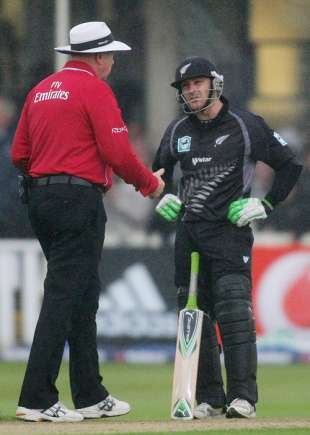|
|
|

Brendon McCullum guided New Zealand's chase of 160 at Edgbaston until rain stopped play one over short of the 20 required to constitute a match
© Getty Images
|
|
| |
Imagine you're a rich Texan billionaire with an entrepreneurial spirit and a truckload of spare cash to invest in a quaint English sport. You've identified a niche of the game that you believe has something going for it, but you've also made it fairly plain that there are two further niches that hold little interest for you. Nevertheless, in the interests of fairness - and because you've encountered one or two dissenters who would have you believe otherwise - you decide to defer judgment until you've seen what it is they've got going for them.
What on earth would you think if you were Allen Stanford and you'd just witnessed the farcical scenes at Edgbaston during last night's ODI between England and New Zealand? Forget about attracting a new audience, it's sometimes hard enough knowing how cricket manages to appeal even to its own aficionados. By the time the last spectators had sidled disconsolately away, shortly after 7.30pm, the hardiest of them had been sat in the buttock-numbing cold for nine relentless hours, only for the match to be aborted just as it threatened to get interesting.
If that synopsis sounds strangely familiar, it's because last night, I think I got a taste of what it must be like to be an American watching Test cricket. Nothing happened for hours on end, there was a flurry of interest and a few incomprehensible regulations were called into play, and then everyone shook hands and left the field with the job half-done. To add to the absurdity, there was even a half-hour break for "tea" during the brightest playing conditions of the day.
For years, all of the above has been written off as part of cricket's "charm" - the sort of confusing scenarios that could be used, in conjunction with witty explanatory tea-towels, to baffle Americans and preserve the game's exclusive appeal. But unfortunately for anyone who still thinks that way, it is an American who has just bought the pavilion, and he's not going to be impressed with such flagrant pointlessness. If Stanford wished to dismiss yesterday's game as "boring", as he did so bluntly with Test cricket during his Lord's launch party last week, there wouldn't be a soul in the sport who could dare suggest he was mistaken.
Of course, Test cricket isn't boring, far from it. But is anyone, from Stanford right down to your 11-year-old kid in the park, actually going to hang around to learn about its intricacies when the image it portrays is so stultifying and misleading? Much as it pains me to admit it, Test cricket needs to adapt, and quickly, or else it too will become as anachronistic as yesterday's unloved ODI.
In recent days there have been murmurings on that front from another sporting anachronism, the ICC, which descended into civil war with the sacking of Malcolm Speed at the end of April and has barely been able to string together a press release in the two turbulent months that have since elapsed. And yet, on June 29, their annual conference gets underway in Dubai, and according to the former president of the BCCI, IS Bindra, the "repackaging" of Test cricket will be high on the agenda.
"It does not mean tinkering with the form, but we are looking at bringing in more audience in Test matches," said Bindra. These were encouraging sentiments because Test cricket does not require a root-and-branch restructuring for its timeless merits to sparkle once again. The means by which Bindra hoped to achieve this aim, however, were rather wider of the mark. "The ICC was looking at ways to increase scoring-rates," he said, "and have a world championship of Test cricket."
| |
|
|
|
| |
| There are three fundamental requirements for unmissable Test cricket: big crowds, sporting pitches and evenly matched teams. The former drives the adrenaline of the participants, the latter two sustain the battle-lust. And yet, for the vast majority of Tests - certainly for those not involving England, Australia or India - the crowds stay away in their droves, and not even the promise of a Kevin Pietersen switch-hitting masterclass could persuade them otherwise |
| |
Scoring-rates in particular are a red herring. There are three fundamental requirements for unmissable Test cricket: big crowds, sporting pitches and evenly matched teams. The former drives the adrenaline of the participants, the latter two sustain the battle-lust. And yet, for the vast majority of Tests - certainly for those not involving England, Australia or India - the crowds stay away in their droves, and not even the promise of a Kevin Pietersen switch-hitting masterclass could persuade them otherwise. Stanford, after all, has been a citizen of Antigua for the past decade, and in that time he has witnessed, at the now-defunct ARG, the making and breaking of more Test batting records than you can fit on an honours board. The gratuity of the run-scoring is probably why he finds it so dull.
It would be simplistic, however, to call for an end to the flat and featureless batting tracks that have taken over the world game. No board in its right mind would actively prepare a wicket to hasten the end of a match, and even fewer have the money or inclination to dig up their tired old squares and relay with a fresh loam mix. A better bet, and one that would deal with the accessibility issue as well, would be to bite the bullet of tradition and accept that the time is right to introduce the floodlit Test.
Admittedly, it would be a wrench to go down such a route, but is the old game really in a position to argue right now? Even the MCC, the spiritual guardian of Test cricket, has been experimenting with a pink ball this season, which is an open acknowledgment that change has to be embraced. Coloured clothing has been around for years, so the shock factor has long since dissipated. Doubtless we'd shed a tear if the 2010-11 Ashes had to be played out in blue versus yellow kits, but we'd get over it if the cricket was up to scratch.
And it is on that point - the standard of the cricket - that floodlit Tests might just have the capacity to change the opinion of the Stanfords of this world. Even though day/night one-day cricket has been a global hit for more than 30 years, the inequality of the conditions has been a cause for concern on more than a few occasions. In South Africa especially, chasing under lights is a hazardous business, and at the 2003 World Cup a whole raft of fixtures were effectively decided at the toss.
There'd be no such concerns in a day/night Test match, however. A side winning the toss would be obliged to start their innings under the mid-afternoon sun, readjust their eyes as twilight kicks in and the floodlights begin to blink into life, then cope with the dewy, swinging conditions of the evening session - which, if they survived that far, would culminate in a ten-over burst against the new ball (or longer, if four 100-over days were introduced). Ricky Ponting recently hinted that run-scoring was getting a bit easy in this day and age, but that sort of ordeal would test every facet of a batsman's skill. And the very best would get to do it all again the following day. The best captains would get the hang of a timely declaration as well.
|
|
|

The day/night format has shown that even a mediocre game of cricket can be a crowd-pulling spectacle, and a prime-time ratings hit for the TV channels as well
© Barmy Army
|
|
| |
There is nothing new in the concept of floodlit Tests - Kerry Packer tried them out with limited success during his World Series Cricket revolution - but they would bring a whole new dimension to a game that, in some parts of the world, seems staid beyond salvation.
Test cricket thrives in England (and survives in Australia) because there are enough fans with enough leisure time and disposable income to justify spending an entire day, dawn to dusk, at a sporting occasion. In the rest of the world, however, attendances are flat-lining because no one in their right minds can be bothered to pay to sit in a sweltering concrete bowl during the hottest parts of the day.
The cool of the tropical evening, on the other hand, is tailormade for such an experience. The day/night format has shown that even a mediocre game of cricket can be a crowd-pulling spectacle, and a prime-time ratings hit for the TV channels as well, and in this money-obsessed age it no longer makes sense to keep Test cricket - the greatest form of the game - cordoned off from the mass market.
And the mass market is the only thing that can save the five-day game. After England's series win over New Zealand at Trent Bridge, the ECB announced a fancy-sounding £2 million prize pool as an incentive for further Test success, but as Mike Atherton pointed out in the Times last week, that works out, between 12 players over 75 days, at a shade over £2000 per day.
In this era of Twenty20 millions, that's hardly worth getting out of bed for. On November 1, many of those same England players stand to earn £500,000 for three hours' work. If fans around the world aren't drawn back to Test cricket, there will be no game worth saving. The time for purity has long since passed.
Andrew Miller is UK editor of Cricinfo

